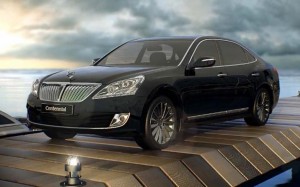Hyundai landed an unexpected body blow to the luxury car segment when it introduced its first-generation Genesis and followed with the well-received Equus, the big sedan taking on the likes of the BMW 7-Series and Mercedes-Benz S-Class.
An updated version of the Hyundai Equus is scheduled to debut at the New York Auto Show later this month but the Korean carmaker doesn’t appear ready to stop there, sources both inside and outside the company telling TheDetroitBureau.com that an expanded line-up of luxury models could follow in the not-too-distant future.
But it now appears extremely unlikely that Hyundai will now follow up with a separate luxury channel for the American market, something it has agonized over in recent years.
The largest of the Korean automakers already sells a broader mix of high-line vehicles in its home market, though not all would be suitable for sale in global markets, the U.S. in particular. But it is continuing to look at various options to tackle more of its high-line competitors’ range. Among those niches that have long been in Hyundai’s sights are the BMW 3-Series and the Lexus RX crossover, which would mean moving notably up-market from the latest-generation Hyundai Santa Fe and Santa Fe Sport remakes launched for 2013.
“We’re always looking at our options,” John Krafcik, CEO of Hyundai Motor America, acknowledged in a conversation with TheDetroitBureau.com during a media drive of the Santa Fe.
The executive declined to say whether specific plans are already in the works, but Krafcik is clearly pleased with the reception the Equus has been receiving. Sales of the well-reviewed sedan have so far outstripped the originally modest expectations. In fact, “If it were a separate brand, it would have been number one,” noted the CEO, in the J.D. Power and Associates Customer Service Index released this week, ahead of Lexus.
The Genesis has done equally well, scoring a coup in its very first year on the U.S. market by being named North American Car of the Year, a first for any Hyundai product – though the mainstream Elantra went on to repeat that victory.
What appears all but certain is that after long debate, Hyundai now will shy away from adding a second brand in the U.S. market to challenge the likes of Lexus and Infiniti, as well as the German luxury brands.
There would be potential advantages to that, the various sources agree, allowing dealers to create an environment specifically focused on the luxury market. But even though several 100 Hyundai dealers apparently were ready to sign on a few years back, the maker couldn’t make a strong enough business case.
It also recognized that by careful targeting it could draw up-market buyers into existing Hyundai showrooms to shop for an Equus and Genesis sedan alongside mainstream buyers looking for more plebian offerings like the Hyundai Elantra and Veloster.
For the moment, those hoping for even more luxurious options from the Koreans will have to settle for the changes coming in 2014 from the Hyundai Equus. Readers will recall seeing a first teaser pic last week. Fully undisguised images of the car have now followed, even though the officials NY Auto Show launch is still more than 10 days away.
Among the updates are subtle revisions to the face of the big sedan, including the addition of new adaptive LED headlamps and redesigned LED tail lights. The 2014 Hyundai Equus will get new 18-inch wheels and tires, with 19s on the option list.
Inside, the cabin has been refined to better suit an assault on the likes of the next-generation Mercedes S-Class soon coming to market. There will be an all-new reconfigurable TFT display in place of the old analog gauges, and a 9.2-inch LCD screen will dominate the center stack.
Technical updates will include a new smart cardkey system and a switch to shift-by-wire. But more telling will be the revisions made to the big sedan’s suspension and steering. Krafcik makes no bones about what has been Hyundai’s big weakness across its product range, “ride dynamics.” He has been pressing Korea to deliver a more sporty, nimble and direct feel, something that begins to be apparent with offerings like the new Santa Fe – which offers drivers a three-mode steering control switch.
The Equus will use electronically damped shocks and provide three driving modes, Normal, Snow and Sport.


That grille looks like a Lincolnesque knock-off from J.C. Whitney. Other than that distinction, the front end looks like Contemporary Generic.
Hi, Sidney,
Ironic, isn’t it, that Lincoln is moving away from the waterfall-style grille to the new open-wing design seen on the new MKZ — which I happen to think is a big improvement, especially compared to some recent versions of the old style.
Paul A. Eisenstein
Publisher, TheDetroitBureau.com